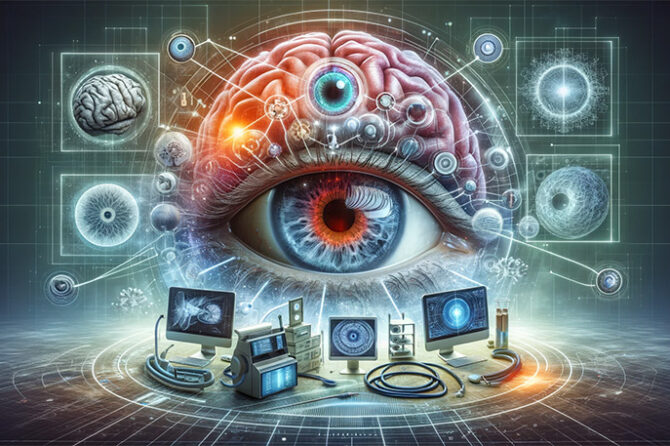
A Beacon of Hope in the Shadow of Memory Loss: The specter of Alzheimer’s disease looms large, a thief of memories and a debilitating foe for millions. Its diagnosis, however, often arrives late, after insidious whispers of cognitive decline morph into undeniable shouts of memory loss. But on the horizon, a beacon of hope shines – a revolutionary approach fuelled by the burgeoning power of Artificial Intelligence (AI) promises to change the game.
As the article in The Wall Street Journal by Vipal Manga, “Is the Eye the Window to Alzheimer’s?“ vividly highlights, current methods for diagnosing Alzheimer’s are far from ideal. Invasive procedures like PET scans and spinal taps, while accurate, are impractical for widespread use due to their expense and intrusiveness. This often leads to delayed diagnoses, hindering the potential for early intervention and treatment.
The Current Landscape: Shadows in the Brain: Today’s path to Alzheimer’s diagnosis remains shrouded in cumbersome and invasive procedures. PET scans and spinal taps, while accurate, are like cumbersome keys to a silent lock – expensive, intrusive, and often reserved for when the disease has already cast its shadow. This late-stage detection leaves precious windows of intervention untended, echoing the poignant words of Henry Ford: “The only real mistake is the one from which we learn nothing.“
Enter the Lightbringer: AI Illuminates the Path: But now, AI steps onto the stage, poised to rewrite the narrative. Companies like RetiSpec and Neurovision are weaving algorithms that can decipher the whispers of Alzheimer’s hidden within the human eye. By meticulously analyzing eye scans and blood tests, these digital sleuths aim to track down the disease’s earliest footprints, potentially decades before symptoms even whisper their arrival.
The Power of Early Sight: AI’s advantage lies in its ability to see what even the keenest human eye might miss. In the vast data landscapes of medical images and genetic information, it discerns subtle patterns, like a master cartographer navigating the intricate contours of an uncharted wilderness. This early detection isn’t merely a scientific triumph; it’s a lifeline. As William Gibson aptly observed, “The future is already here – it’s just not evenly distributed.” By bringing the future of Alzheimer’s detection to the present, AI offers a chance to rewrite the narrative – not from one of loss and decline, but of proactive intervention and potential hope.

Benefits Beyond Compare: The advantages of AI-powered diagnosis are like sunbeams piercing the fog:
- Early Intervention: No longer tethered to late-stage detection, doctors could potentially intervene in the disease’s earliest stages, potentially altering its course and offering a fighting chance.
- Non-Invasive and Cost-Effective: Gone are the days of invasive procedures and exorbitant costs. AI-based methods promise gentler examinations and easier access to diagnosis, democratizing healthcare and making early detection a reality for all.
- Routine Scrutiny: Imagine a world where Alzheimer’s screening becomes as routine as an eye exam. By seamlessly integrating AI into ophthalmologic diagnostics, we could catch the disease in its nascency, much like the revolution AI has brought to diabetic retinopathy screening.
Challenges and Cautions: Navigating the Uncharted: With all its promise, AI’s path is not without its thorns. Two key challenges stand in the way:
- Data Diversity and Volume: Like a cartographer lost in a map-less land, AI models need vast, diverse datasets to navigate the complexities of human biology. Ensuring inclusivity and avoiding bias in these datasets is crucial to ensure AI’s efficacy for all.
- Real-World Performance: The controlled environments of clinical trials rarely reflect the messy reality of clinical settings. Ensuring AI’s accuracy and adaptability in real-world situations is vital for its successful integration into healthcare.
Embracing the Dawn: A Future Written in Early Detection: While AI’s role in Alzheimer’s diagnosis is still embryonic, the future whispers with exciting possibilities. Extensive clinical trials and further research hold the key to unlocking its full potential, like the seeds for a brighter tomorrow waiting to be sown. Just as AI’s role in cancer diagnosis, though still evolving, has shown its potential for early detection and improved patient outcomes, so too does AI in Alzheimer’s research offer a glimpse into a future where memory loss doesn’t signify an inevitable decline, but a treatable condition tackled head-on.
A Shared Journey: Acknowledgement and Inspiration: This exploration owes a debt of gratitude to Vipal Manga‘s insightful article in The Wall Street Journal, “Is the Eye the Window to Alzheimer’s?“, for shedding light on this vital frontier of medical technology.
Beyond the Eye: AI’s Multifaceted Touch: The article also paints a wider canvas, showcasing AI’s multifaceted potential in Alzheimer’s research. From identifying genetic triggers to predicting disease progression, AI is like a versatile artist, crafting solutions across the Alzheimer’s landscape. As Andrew Ng aptly states, “AI is the new electricity,” and its energy is electrifying the field of medical research.
Stepping into the Light: The challenges are real, but the potential is undeniable. As we embrace AI in the realm of Alzheimer’s diagnosis.

Call to action:
- Advocate for increased funding and government support for AI research in Alzheimer’s.
- Encourage collaboration between academic institutions, tech companies, and healthcare providers to accelerate research and development.
- Promote public awareness about the potential of AI for early Alzheimer’s diagnosis.
Prof. Dr. Prahlada N. B
31 December 2023
Doha, Qatar.
References:
Articles:
- “Is the Eye the Window to Alzheimer’s?” by Vipal Manga, The Wall Street Journal
- “AI could diagnose Alzheimer’s disease 20 years early using eye scans” by Science News
- “Deep Learning in Diagnosis and Prognosis of Alzheimer’s Disease” by Nature Machine Intelligence
Books:
- “Deep Learning for Healthcare: Revolutionizing Medicine with Artificial Intelligence” by Andre Esteva et al.
- “Machine Learning for Healthcare: Predictive, Preventive, and Personalized Medicine” by Raschka and Mirjalili

















Leave a reply